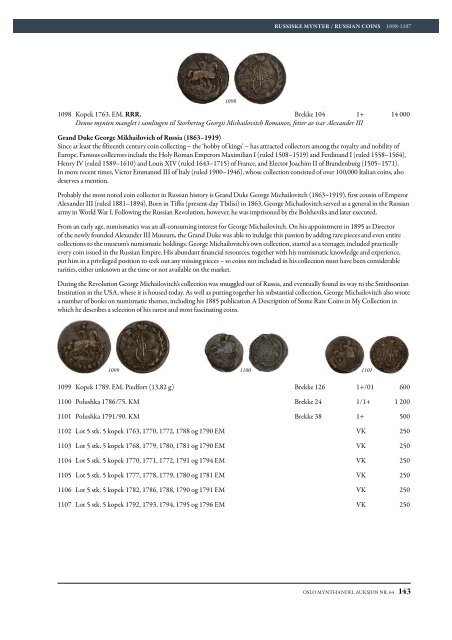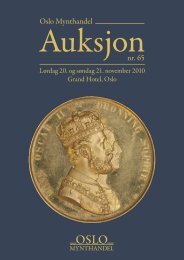Uten navn - Simpleweb AS
Uten navn - Simpleweb AS
Uten navn - Simpleweb AS
You also want an ePaper? Increase the reach of your titles
YUMPU automatically turns print PDFs into web optimized ePapers that Google loves.
1098<br />
RUSSISKE MYNTER / RUSSIAN COINS<br />
1098 Kopek 1763. EM. RRR. Brekke 104 1+ 14 000<br />
Denne mynten manglet i samlingen til Storhertug Georgii Michailovitch Romanov, fetter av tsar Alexander III<br />
Grand Duke George Mikhailovich of Russia (1863–1919)<br />
Since at least the eenth century coin collecting – the ‘hobby of kings’ – has attracted collectors among the royalty and nobility of<br />
Europe. Famous collectors include the Holy Roman Emperors Maximilian I (ruled 1508–1519) and Ferdinand I (ruled 1558–1564),<br />
Henry IV (ruled 1589–1610) and Louis XIV (ruled 1643–1715) of France, and Elector Joachim II of Brandenburg (1505–1571).<br />
In more recent times, Victor Emmanuel III of Italy (ruled 1900–1946), whose collection consisted of over 100,000 Italian coins, also<br />
deserves a mention.<br />
Probably the most noted coin collector in Russian history is Grand Duke George Michailovitch (1863–1919), rst cousin of Emperor<br />
Alexander III (ruled 1881–1894). Born in Tiis (present-day Tbilisi) in 1863, George Michailovitch served as a general in the Russian<br />
army in World War I. Following the Russian Revolution, however, he was imprisoned by the Bolsheviks and later executed.<br />
From an early age, numismatics was an all-consuming interest for George Michailovitch. On his appointment in 1895 as Director<br />
of the newly founded Alexander III Museum, the Grand Duke was able to indulge this passion by adding rare pieces and even entire<br />
collections to the museum’s numismatic holdings. George Michailovitch’s own collection, started as a teenager, included practically<br />
every coin issued in the Russian Empire. His abundant nancial resources, together with his numismatic knowledge and experience,<br />
put him in a privileged position to seek out any missing pieces – so coins not included in his collection must have been considerable<br />
rarities, either unknown at the time or not available on the market.<br />
During the Revolution George Michailovitch’s collection was smuggled out of Russia, and eventually found its way to the Smithsonian<br />
Institution in the USA, where it is housed today. As well as putting together his substantial collection, George Michailovitch also wrote<br />
a number of books on numismatic themes, including his 1885 publication A Description of Some Rare Coins in My Collection in<br />
which he describes a selection of his rarest and most fascinating coins.<br />
1099 1100 1101<br />
1098-1107<br />
1099 Kopek 1789. EM. Piedfort (13,82 g) Brekke 126 1+/01 600<br />
1100 Polushka 1786/75. KM Brekke 24 1/1+ 1 200<br />
1101 Polushka 1791/90. KM Brekke 38 1+ 500<br />
1102 Lot 5 stk. 5 kopek 1763, 1770, 1772, 1788 og 1790 EM VK 250<br />
1103 Lot 5 stk. 5 kopek 1768, 1779, 1780, 1781 og 1790 EM VK 250<br />
1104 Lot 5 stk. 5 kopek 1770, 1771, 1772, 1791 og 1794 EM VK 250<br />
1105 Lot 5 stk. 5 kopek 1777, 1778, 1779, 1780 og 1781 EM VK 250<br />
1106 Lot 5 stk. 5 kopek 1782, 1786, 1788, 1790 og 1791 EM VK 250<br />
1107 Lot 5 stk. 5 kopek 1792, 1793, 1794, 1795 og 1796 EM VK 250<br />
OSLO MYNTHANDEL AUKSJON NR. 64 143



